dashboard JEEP RENEGADE 2018 Owner handbook (in English)
[x] Cancel search | Manufacturer: JEEP, Model Year: 2018, Model line: RENEGADE, Model: JEEP RENEGADE 2018Pages: 356, PDF Size: 6.11 MB
Page 13 of 356
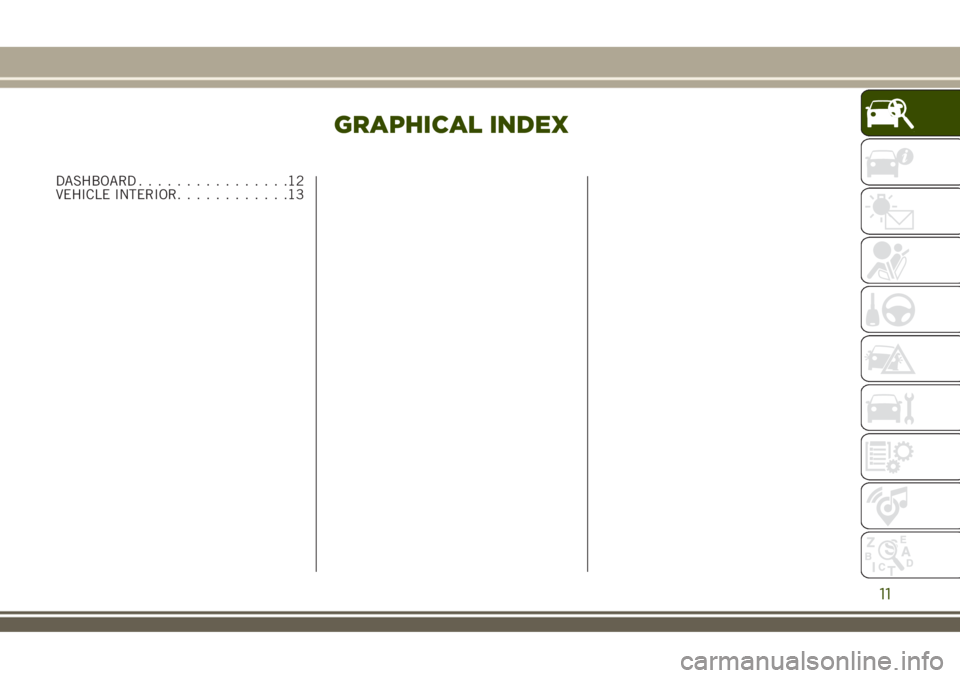
GRAPHICAL INDEX
DASHBOARD................12
VEHICLE INTERIOR............13
11
Page 14 of 356
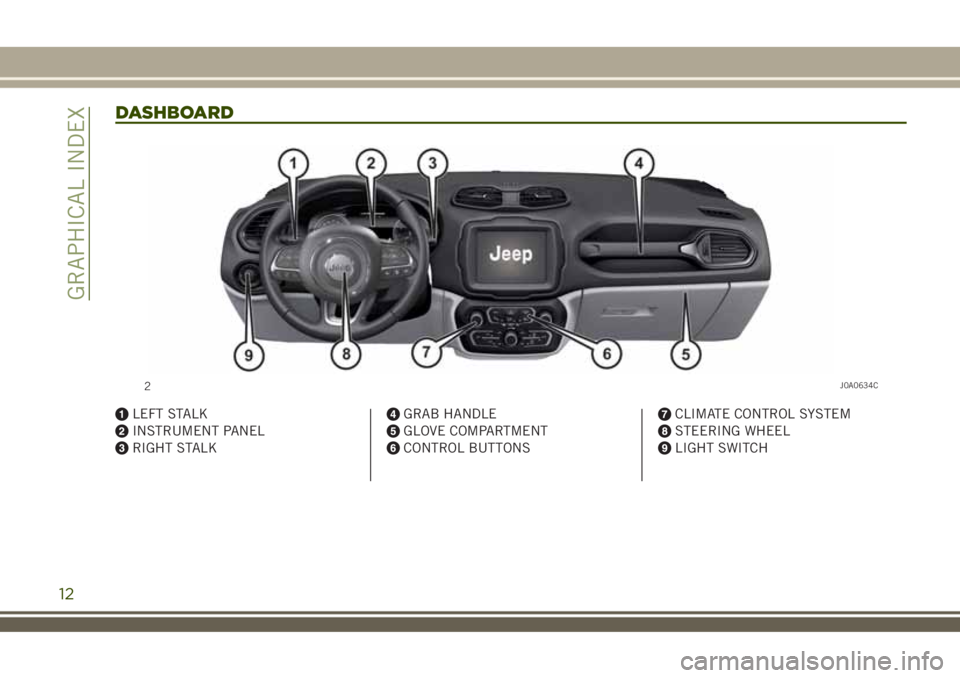
DASHBOARD
LEFT STALK
INSTRUMENT PANEL
RIGHT STALK
GRAB HANDLE
GLOVE COMPARTMENT
CONTROL BUTTONS
CLIMATE CONTROL SYSTEM
STEERING WHEEL
LIGHT SWITCH
2J0A0634C
12
GRAPHICAL INDEX
Page 30 of 356
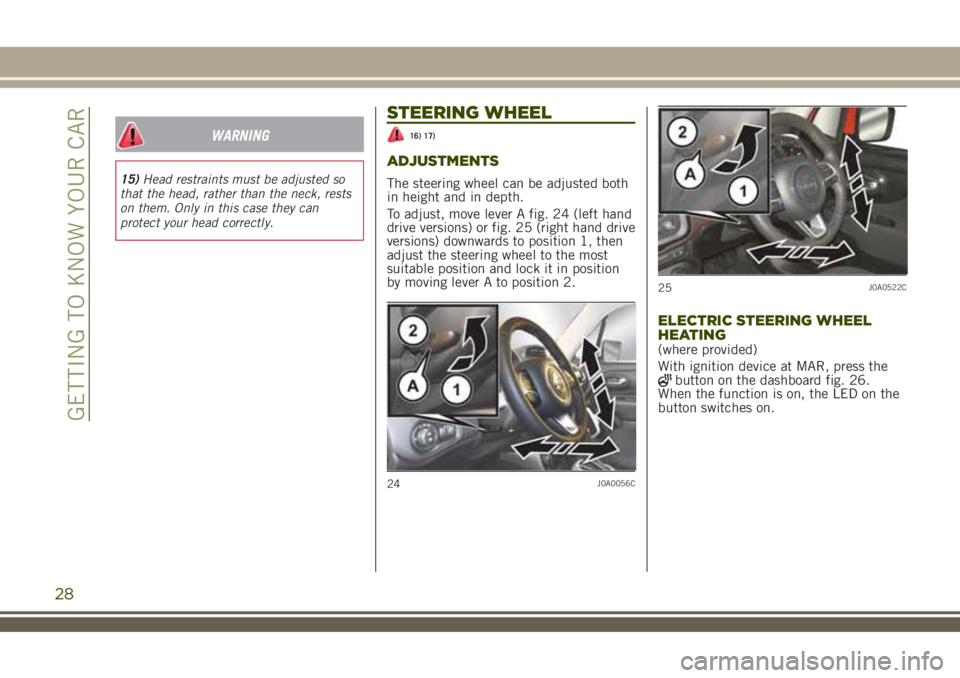
WARNING
15)Head restraints must be adjusted so
that the head, rather than the neck, rests
on them. Only in this case they can
protect your head correctly.
STEERING WHEEL
16) 17)
ADJUSTMENTS
The steering wheel can be adjusted both
in height and in depth.
To adjust, move lever A fig. 24 (left hand
drive versions) or fig. 25 (right hand drive
versions) downwards to position 1, then
adjust the steering wheel to the most
suitable position and lock it in position
by moving lever A to position 2.
ELECTRIC STEERING WHEEL
HEATING
(where provided)
With ignition device at MAR, press the
button on the dashboard fig. 26.
When the function is on, the LED on the
button switches on.
24J0A0056C
25J0A0522C
28
GETTING TO KNOW YOUR CAR
Page 33 of 356
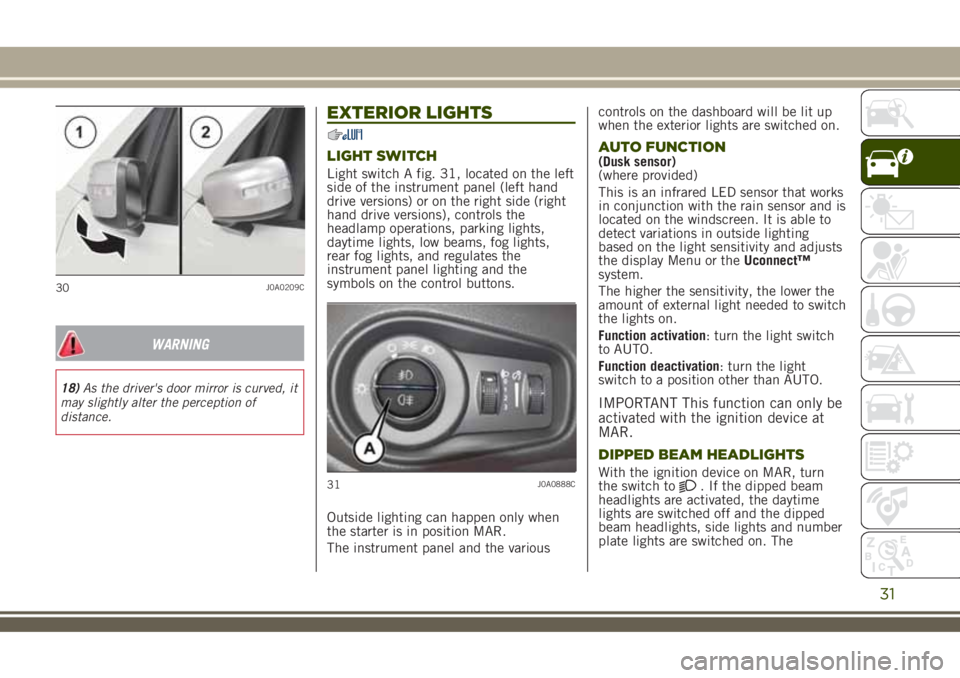
WARNING
18)As the driver's door mirror is curved, it
may slightly alter the perception of
distance.
EXTERIOR LIGHTS
LIGHT SWITCH
Light switch A fig. 31, located on the left
side of the instrument panel (left hand
drive versions) or on the right side (right
hand drive versions), controls the
headlamp operations, parking lights,
daytime lights, low beams, fog lights,
rear fog lights, and regulates the
instrument panel lighting and the
symbols on the control buttons.
Outside lighting can happen only when
the starter is in position MAR.
The instrument panel and the variouscontrols on the dashboard will be lit up
when the exterior lights are switched on.
AUTO FUNCTION(Dusk sensor)
(where provided)
This is an infrared LED sensor that works
in conjunction with the rain sensor and is
located on the windscreen. It is able to
detect variations in outside lighting
based on the light sensitivity and adjusts
the display Menu or theUconnect™
system.
The higher the sensitivity, the lower the
amount of external light needed to switch
the lights on.
Function activation: turn the light switch
to AUTO.
Function deactivation: turn the light
switch to a position other than AUTO.
IMPORTANT This function can only be
activated with the ignition device at
MAR.
DIPPED BEAM HEADLIGHTS
With the ignition device on MAR, turn
the switch to. If the dipped beam
headlights are activated, the daytime
lights are switched off and the dipped
beam headlights, side lights and number
plate lights are switched on. The
30J0A0209C
31J0A0888C
31
Page 36 of 356
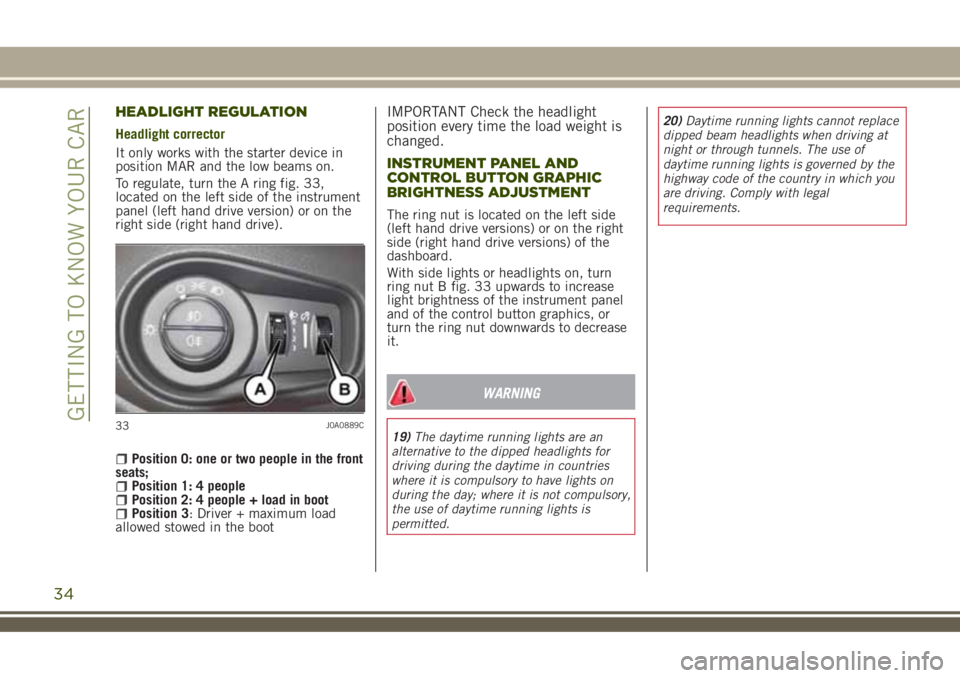
HEADLIGHT REGULATION
Headlight corrector
It only works with the starter device in
position MAR and the low beams on.
To regulate, turn the A ring fig. 33,
located on the left side of the instrument
panel (left hand drive version) or on the
right side (right hand drive).
Position 0: one or two people in the front
seats;
Position 1: 4 peoplePosition 2: 4 people + load in bootPosition 3: Driver + maximum load
allowed stowed in the boot
IMPORTANT Check the headlight
position every time the load weight is
changed.
INSTRUMENT PANEL AND
CONTROL BUTTON GRAPHIC
BRIGHTNESS ADJUSTMENT
The ring nut is located on the left side
(left hand drive versions) or on the right
side (right hand drive versions) of the
dashboard.
With side lights or headlights on, turn
ring nut B fig. 33 upwards to increase
light brightness of the instrument panel
and of the control button graphics, or
turn the ring nut downwards to decrease
it.
WARNING
19)The daytime running lights are an
alternative to the dipped headlights for
driving during the daytime in countries
where it is compulsory to have lights on
during the day; where it is not compulsory,
the use of daytime running lights is
permitted.20)Daytime running lights cannot replace
dipped beam headlights when driving at
night or through tunnels. The use of
daytime running lights is governed by the
highway code of the country in which you
are driving. Comply with legal
requirements.33J0A0889C
34
GETTING TO KNOW YOUR CAR
Page 39 of 356
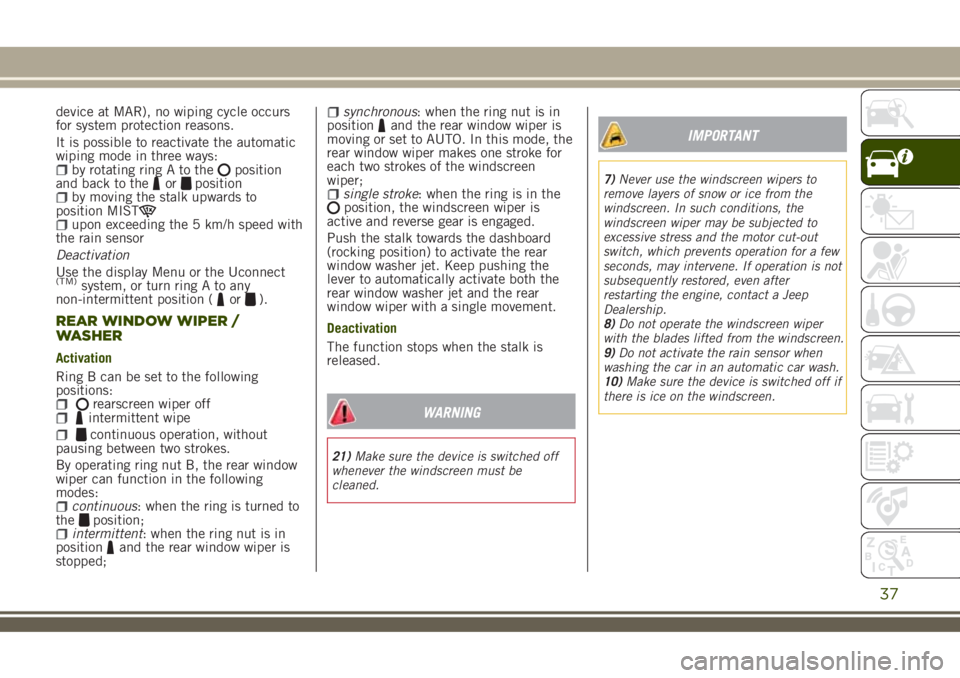
device at MAR), no wiping cycle occurs
for system protection reasons.
It is possible to reactivate the automatic
wiping mode in three ways:
by rotating ring A to theposition
and back to theorpositionby moving the stalk upwards to
position MIST
upon exceeding the 5 km/h speed with
the rain sensor
Deactivation
Use the display Menu or the Uconnect
(TM)system, or turn ring A to any
non-intermittent position (or).
REAR WINDOW WIPER /
WASHER
Activation
Ring B can be set to the following
positions:
rearscreen wiper offintermittent wipe
continuous operation, without
pausing between two strokes.
By operating ring nut B, the rear window
wiper can function in the following
modes:
continuous: when the ring is turned to
theposition;intermittent: when the ring nut is in
positionand the rear window wiper is
stopped;
synchronous: when the ring nut is in
positionand the rear window wiper is
moving or set to AUTO. In this mode, the
rear window wiper makes one stroke for
each two strokes of the windscreen
wiper;
single stroke: when the ring is in theposition, the windscreen wiper is
active and reverse gear is engaged.
Push the stalk towards the dashboard
(rocking position) to activate the rear
window washer jet. Keep pushing the
lever to automatically activate both the
rear window washer jet and the rear
window wiper with a single movement.
Deactivation
The function stops when the stalk is
released.
WARNING
21)Make sure the device is switched off
whenever the windscreen must be
cleaned.
IMPORTANT
7)Never use the windscreen wipers to
remove layers of snow or ice from the
windscreen. In such conditions, the
windscreen wiper may be subjected to
excessive stress and the motor cut-out
switch, which prevents operation for a few
seconds, may intervene. If operation is not
subsequently restored, even after
restarting the engine, contact a Jeep
Dealership.
8)Do not operate the windscreen wiper
with the blades lifted from the windscreen.
9)Do not activate the rain sensor when
washing the car in an automatic car wash.
10)Make sure the device is switched off if
there is ice on the windscreen.
37
Page 41 of 356
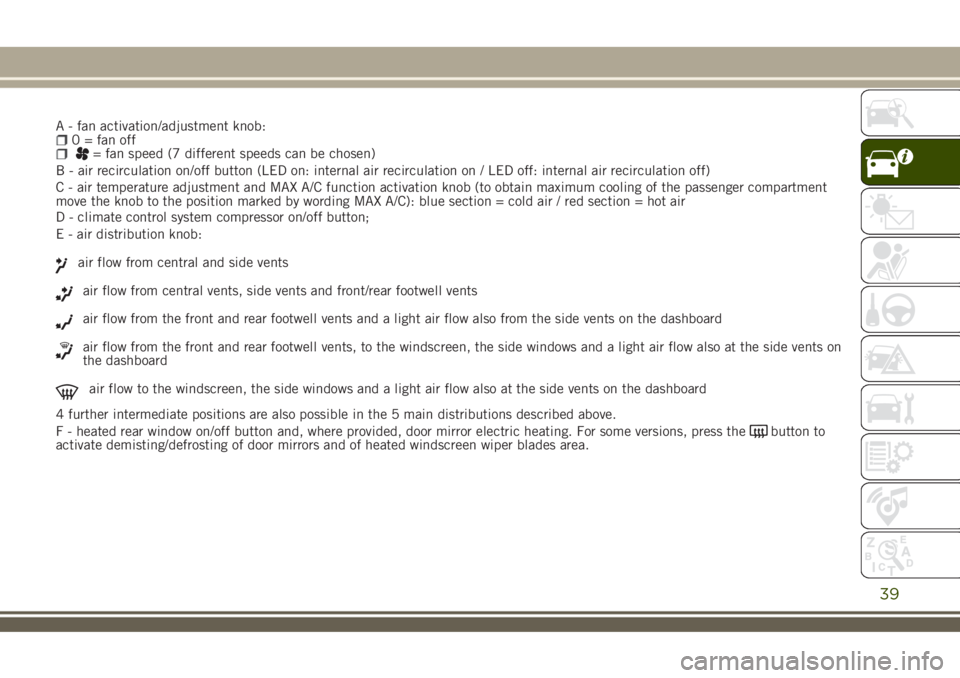
A - fan activation/adjustment knob:0 = fan off= fan speed (7 different speeds can be chosen)
B - air recirculation on/off button (LED on: internal air recirculation on / LED off: internal air recirculation off)
C - air temperature adjustment and MAX A/C function activation knob (to obtain maximum cooling of the passenger compartment
move the knob to the position marked by wording MAX A/C): blue section = cold air / red section = hot air
39
D - climate control system compressor on/off button;
E - air distribution knob:
air flow from central and side vents
air flow from central vents, side vents and front/rear footwell vents
air flow from the front and rear footwell vents and a light air flow also from the side vents on the dashboard
air flow from the front and rear footwell vents, to the windscreen, the side windows and a light air flow also at the side vents on
the dashboard
air flow to the windscreen, the side windows and a light air flow also at the side vents on the dashboard
4 further intermediate positions are also possible in the 5 main distributions described above.
F - heated rear window on/off button and, where provided, door mirror electric heating. For some versions, press the
button to
activate demisting/defrosting of door mirrors and of heated windscreen wiper blades area.
Page 46 of 356
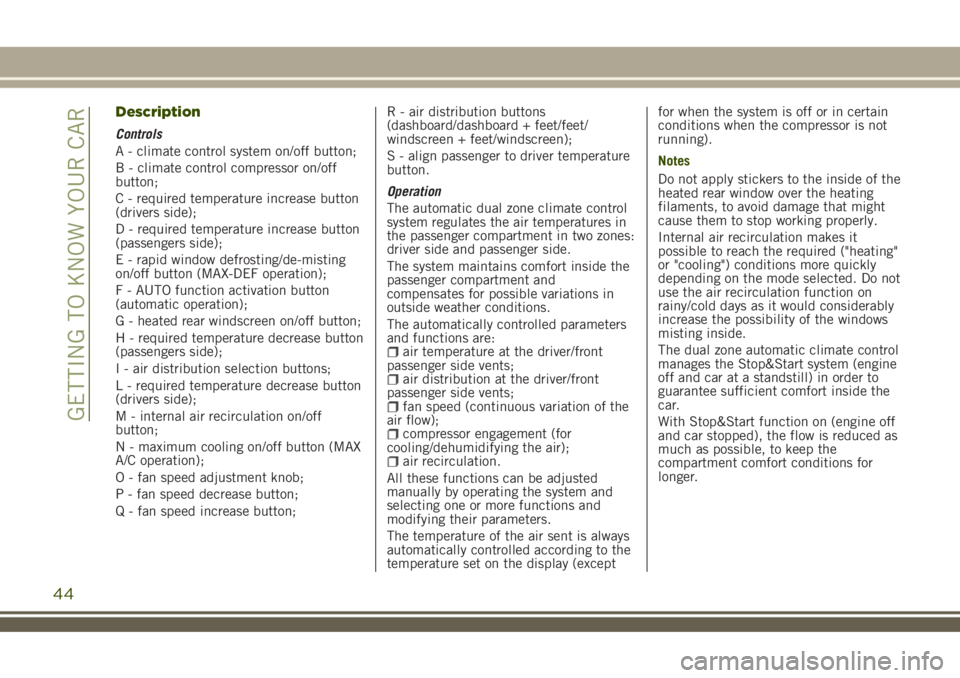
Description
Controls
A - climate control system on/off button;
B - climate control compressor on/off
button;
C - required temperature increase button
(drivers side);
D - required temperature increase button
(passengers side);
E - rapid window defrosting/de-misting
on/off button (MAX-DEF operation);
F - AUTO function activation button
(automatic operation);
G - heated rear windscreen on/off button;
H - required temperature decrease button
(passengers side);
I - air distribution selection buttons;
L - required temperature decrease button
(drivers side);
M - internal air recirculation on/off
button;
N - maximum cooling on/off button (MAX
A/C operation);
O - fan speed adjustment knob;
P - fan speed decrease button;
Q - fan speed increase button;R - air distribution buttons
(dashboard/dashboard + feet/feet/
windscreen + feet/windscreen);
S - align passenger to driver temperature
button.
Operation
The automatic dual zone climate control
system regulates the air temperatures in
the passenger compartment in two zones:
driver side and passenger side.
The system maintains comfort inside the
passenger compartment and
compensates for possible variations in
outside weather conditions.
The automatically controlled parameters
and functions are:
air temperature at the driver/front
passenger side vents;
air distribution at the driver/front
passenger side vents;
fan speed (continuous variation of the
air flow);
compressor engagement (for
cooling/dehumidifying the air);
air recirculation.
All these functions can be adjusted
manually by operating the system and
selecting one or more functions and
modifying their parameters.
The temperature of the air sent is always
automatically controlled according to the
temperature set on the display (exceptfor when the system is off or in certain
conditions when the compressor is not
running).
Notes
Do not apply stickers to the inside of the
heated rear window over the heating
filaments, to avoid damage that might
cause them to stop working properly.
Internal air recirculation makes it
possible to reach the required ("heating"
or "cooling") conditions more quickly
depending on the mode selected. Do not
use the air recirculation function on
rainy/cold days as it would considerably
increase the possibility of the windows
misting inside.
The dual zone automatic climate control
manages the Stop&Start system (engine
off and car at a standstill) in order to
guarantee sufficient comfort inside the
car.
With Stop&Start function on (engine off
and car stopped), the flow is reduced as
much as possible, to keep the
compartment comfort conditions for
longer.
44
GETTING TO KNOW YOUR CAR
Page 90 of 356
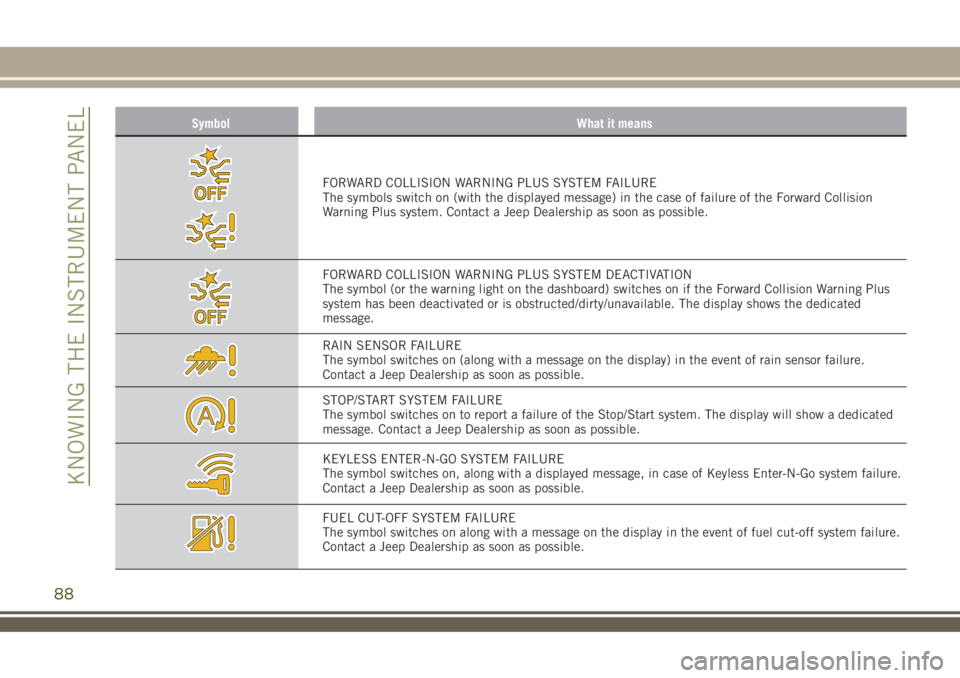
Symbol What it means
FORWARD COLLISION WARNING PLUS SYSTEM FAILURE
The symbols switch on (with the displayed message) in the case of failure of the Forward Collision
Warning Plus system. Contact a Jeep Dealership as soon as possible.
FORWARD COLLISION WARNING PLUS SYSTEM DEACTIVATION
The symbol (or the warning light on the dashboard) switches on if the Forward Collision Warning Plus
system has been deactivated or is obstructed/dirty/unavailable. The display shows the dedicated
message.
RAIN SENSOR FAILURE
The symbol switches on (along with a message on the display) in the event of rain sensor failure.
Contact a Jeep Dealership as soon as possible.
STOP/START SYSTEM FAILURE
The symbol switches on to report a failure of the Stop/Start system. The display will show a dedicated
message. Contact a Jeep Dealership as soon as possible.
KEYLESS ENTER-N-GO SYSTEM FAILURE
The symbol switches on, along with a displayed message, in case of Keyless Enter-N-Go system failure.
Contact a Jeep Dealership as soon as possible.
FUEL CUT-OFF SYSTEM FAILURE
The symbol switches on along with a message on the display in the event of fuel cut-off system failure.
Contact a Jeep Dealership as soon as possible.
88
KNOWING THE INSTRUMENT PANEL
Page 138 of 356
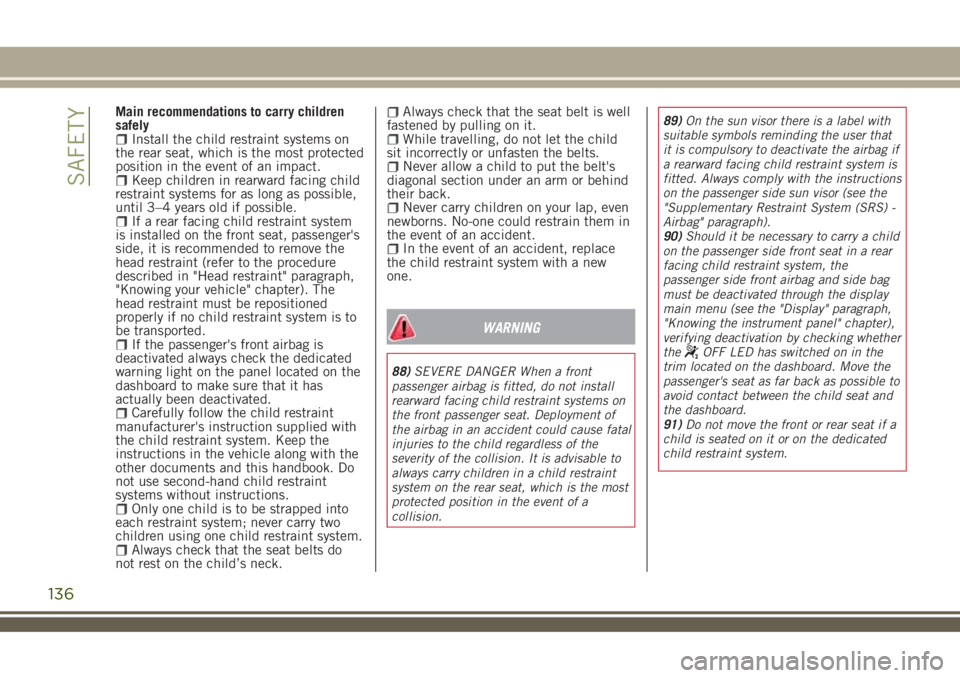
Main recommendations to carry children
safely
Install the child restraint systems on
the rear seat, which is the most protected
position in the event of an impact.
Keep children in rearward facing child
restraint systems for as long as possible,
until 3–4 years old if possible.
If a rear facing child restraint system
is installed on the front seat, passenger's
side, it is recommended to remove the
head restraint (refer to the procedure
described in "Head restraint" paragraph,
"Knowing your vehicle" chapter). The
head restraint must be repositioned
properly if no child restraint system is to
be transported.
If the passenger's front airbag is
deactivated always check the dedicated
warning light on the panel located on the
dashboard to make sure that it has
actually been deactivated.
Carefully follow the child restraint
manufacturer's instruction supplied with
the child restraint system. Keep the
instructions in the vehicle along with the
other documents and this handbook. Do
not use second-hand child restraint
systems without instructions.
Only one child is to be strapped into
each restraint system; never carry two
children using one child restraint system.
Always check that the seat belts do
not rest on the child’s neck.
Always check that the seat belt is well
fastened by pulling on it.
While travelling, do not let the child
sit incorrectly or unfasten the belts.
Never allow a child to put the belt's
diagonal section under an arm or behind
their back.
Never carry children on your lap, even
newborns. No-one could restrain them in
the event of an accident.
In the event of an accident, replace
the child restraint system with a new
one.
WARNING
88)SEVERE DANGER When a front
passenger airbag is fitted, do not install
rearward facing child restraint systems on
the front passenger seat. Deployment of
the airbag in an accident could cause fatal
injuries to the child regardless of the
severity of the collision. It is advisable to
always carry children in a child restraint
system on the rear seat, which is the most
protected position in the event of a
collision.89)On the sun visor there is a label with
suitable symbols reminding the user that
it is compulsory to deactivate the airbag if
a rearward facing child restraint system is
fitted. Always comply with the instructions
on the passenger side sun visor (see the
"Supplementary Restraint System (SRS) -
Airbag" paragraph).
90)Should it be necessary to carry a child
on the passenger side front seat in a rear
facing child restraint system, the
passenger side front airbag and side bag
must be deactivated through the display
main menu (see the "Display" paragraph,
"Knowing the instrument panel" chapter),
verifying deactivation by checking whether
the
OFF LED has switched on in the
trim located on the dashboard. Move the
passenger's seat as far back as possible to
avoid contact between the child seat and
the dashboard.
91)Do not move the front or rear seat if a
child is seated on it or on the dedicated
child restraint system.
136
SAFETY